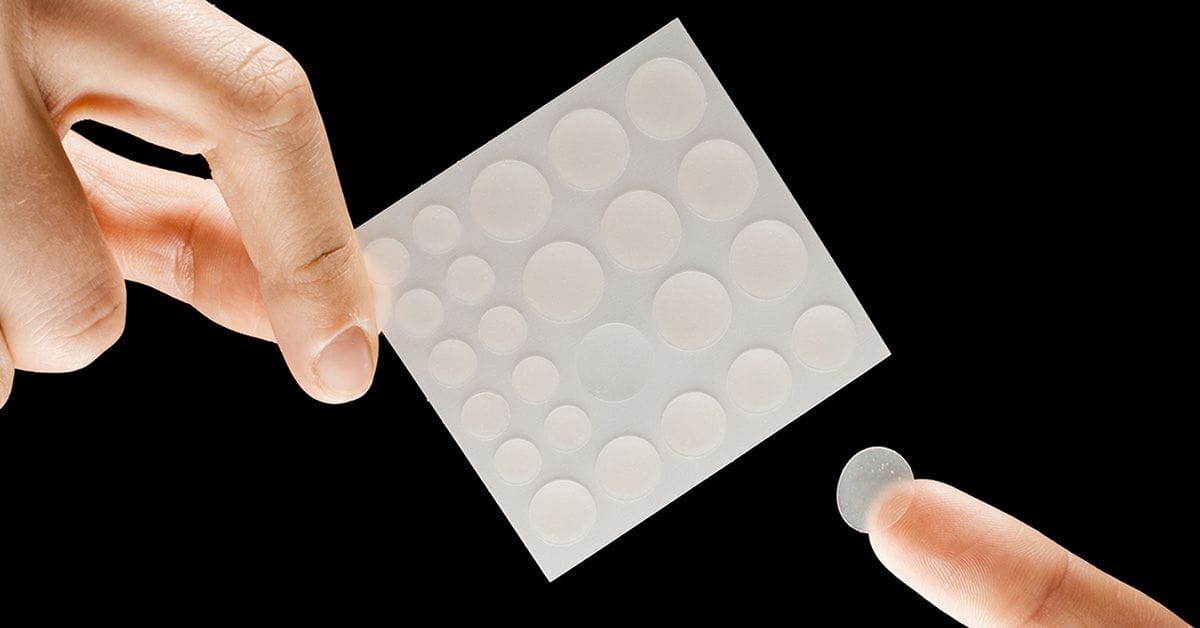Researchers have created a dual-phase self-locking patch that clears acne in days, reduces sebum production, and may hold promise beyond dermatology.

Acne is one of the most common skin conditions worldwide, affecting roughly 85% of adolescents to some degree. And it's more than just skin deep—for many, acne extends well into adulthood, often leaving visible scarring and negative impacts on one's mental health and self-esteem. Effective treatment needs a multi-pronged approach to target the three key aspects of microbial overgrowth, excessive sebum production, and inflammatory processes before these lasting effects take hold.
Fortunately, we've come a long way from the questionable "10 Zit-Zapping Tips and Tricks!" articles of early-aughts teen magazines. Conventional therapies are more widely available than ever, with ingredients that cater to a diverse spectrum of skin types and sensitivities. Common products range from topical agents such as retinoids and benzoyl peroxide to systemic antibiotics and hormonal agents. Despite the abundance of treatments on the market, most therapies have their limitations:
- Creams and gels often cannot penetrate deeply enough into the skin.
- Oral antibiotics sometimes risk resistance.
- Many products fail to adequately address both bacteria and the inflammation that drives breakouts.
Researchers have been investigating microneedle and microarray technologies as a promising alternative, since these tiny projections can bypass the skin's outer barrier and deliver active ingredients more effectively. Yet many existing microarray systems still fall short. Over-the-counter pimple patch users may know the frustration of going to bed with one perfectly placed on their cheek—only to wake up and find it has migrated somewhere else on their face (or off it entirely). In addition to adhesion struggles, there are also limitations surrounding sustained drug release and the ability to target multiple factors at once.
A two-phase approach to treatment
To overcome these struggles, researchers in South Korea have developed a dual-phase self-locking microarray patch designed specifically for acne treatment. The patch features a unique geometry that allows it to "lock" into the skin, ensuring stability during wear and complete insertion for drug delivery.
The innovation also lies within the patch's sequential release system. The researchers engineered two distinct types of patches:
- Phase 1 delivers an antibacterial agent to quickly reduce Cutibacterium acnes, the bacteria most associated with acne development.
- Phase 2 follows with an anti-inflammatory agent to calm down irritation and redness while supporting skin recovery.
The patches were constructed using a mold-casting process with hyaluronic acid, a biocompatible ingredient already widely used in dermatology. Before conducting clinical trials, the team tested the patches' physical durability, penetration ability, adhesion, and stability under different storage conditions.
Impressive clinical outcomes
Clinical trial participants with mild-to-moderate acne applied the antibacterial patch on the first day, followed by daily applications of the anti-inflammatory patch over the next six days. The results, published in ACS Applied Materials & Interfaces, revealed:
- An 81.4% reduction in acne lesions within just 3 days
- Complete clearance of treated lesions by day 7
- A 40.7% decrease in sebum production
The participants reported high satisfaction with the patches, and no significant adverse reactions were observed. Untreated control lesions among the same participants did not show similar improvements, underscoring the effectiveness of the self-locking microarrays.
Broader applications beyond acne
The researchers see much broader potential beyond acne. "Our work highlights the potential of microarray patches as a platform for applications beyond acne treatment, ranging from skin disorders to obesity therapies and vaccine delivery,” explains Corresponding Author Yong-Hee Kim in a recent ACS press release.
Because the patch allows precise control over geometry and drug release, it could be adapted to address other skin concerns such as psoriasis and eczema, where staged delivery of active compounds could produce favorable outcomes. The system could also be applied to wound care to accelerate healing and reduce infection. And because the patches' production cost is comparable to common topical products, they could eventually represent an even more widely accessible and user-friendly alternative to conventional therapies.
Explore more articles on microneedle and microarray technologies in ACS journals
Separable Microneedle Patch Integrated with the Dictamnine-Loaded Copper MOF Nanozyme for Atopic Dermatitis Treatment
Shuyun Liu, Rui Xin, Xinyue Zhang, and Lu Han*
DOI: 10.1021/acsami.5c02334
Bimetallic Metal–Organic Framework Microneedle Array for Wound Healing through Targeted Reactive Oxygen Species Generation and Electron Transfer Disruption
Sirong Sun, Xiangyu Liu, Xiangdan Meng*, Zhou Yang*, Xueji Zhang, and Haifeng Dong*
DOI: 10.1021/acsnano.5c02923
Integrated 3D-Printed Hollow Microneedle Array and Lateral Flow Immunoassay for Point-of-Care Wound Healing Monitoring
Amadeo Sena-Torralba*, Marc Parrilla, Ana Hernanz-Grimalt, Annemarijn Steijlen, Elena Ortiz-Zapater, Cristina Cabaleiro-Otero, Natividad López-Riquelme, Salvador Cerveró-Ferragut, Ángel Maquieira, Karolien De Wael, and Sergi Morais*
DOI: 10.1021/acs.analchem.4c05688
Dissolving Hyaluronic Acid-Based Microneedles to Transdermally Deliver Eugenol Combined with Photothermal Therapy for Acne Vulgaris Treatment
Qi Wang, Zhiyang Gan, Xinxin Wang, Xinying Li, Lei Zhao, Derong Li, Zhilang Xu, Changdao Mu, Liming Ge*, and Defu Li*
DOI: 10.1021/acsami.4c01790
Adhesive Antibacterial Moisturizing Nanostructured Skin Patch for Sustainable Development of Atopic Dermatitis Treatment in Humans
Alicja Kosik-Kozioł, Paweł Nakielski, Daniel Rybak, Wiktoria Frączek, Chiara Rinoldi, Massimiliano Lanzi, Marta Grodzik, and Filippo Pierini*
10.1021/acsami.4c06662
Bioresponsive Nanoarchitectonics-Integrated Microneedles for Amplified Chemo-Photodynamic Therapy against Acne Vulgaris
Ting Wen, Zhiyuan Lin, Yiting Zhao, Yixian Zhou, Boyi Niu, Chaonan Shi, Chao Lu, Xinguo Wen, Minmin Zhang, Guilan Quan*, Chuanbin Wu, and Xin Pan*
DOI: 10.1021/acsami.1c15673
